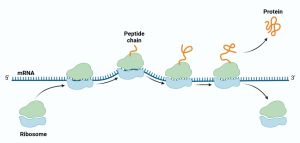3 Eukaryotic Translation
In this chapter, we will review several aspects of eukaryotic translation, including the overall translation process, the assembly of the translation machinery and its regulation.
Learning Outcomes
By the end of this chapter, you will be able to
- Identify the steps in eukaryotic protein synthesis.
- List the steps of tRNA Aminoacylation.
- Identify the steps involved in the initiation, elongation and termination of protein translation.
When you hear the term ‘translation,’ what comes to mind? You may immediately think of proteins or ribosomes, but there is much more to it! We will begin this chapter by reviewing the overall translation process and the components involved.
Protein Translation
Translation is the process through which ribosomes decode the genetic information carried by mRNA to synthesize proteins.

Players of Translation
Before we get into the specific translation steps, let’s begin with reviewing the players involved in the process. Complete the following interactive as a review of the components and their role in eukaryotic translation.
Learning tip! Try to think of each component’s role before you reveal.
Stages of Translation
Now that you have recalled the players involved in protein translation, can you remember what happens at each of the three stages during translation? Complete the following interactive to review.
Before we take a closer look at what is involved at each step, we will begin with a review of tRNA aminoacylation.
tRNA Aminoacylation
tRNA aminoacylation, or tRNA charging, is the process where each tRNA molecule is linked to a corresponding amino acid.
Complete the following interactive to review the steps involved in tRNA aminoacylation.
Learning tip! Try to think about the next step before you click the next arrow.
Adapted from “Aminoacyl-tRNA Synthetases in tRNA Amino Acid Charging”, by BioRender.com (2024).
Initiation of Translation
Let’s now review the details of each step in protein synthesis. First, we will start with initiation. Complete the following interactive to review the assembly and process of this step.
Learning tip! Click on the text to read the details of each step as you sort them in order.
Adapted from “Protein Translation Cascade”, by BioRender.com (2024).
Elongation of Translation
Before we look at the specific steps in the elongation of translation, we will review the aminoacyl-tRNA binding sites of the ribosome. Complete the following interactive as a review.
Now that you are familiar with the binding sites in a ribosome let’s look closer at the steps of elongation. Complete the following interactive as you review the steps involved in elongation and be sure to consider what is going on in the tRNA binding sites in each step.
Learning tip! Think about the description of each step before you flip the card.
Adapted from “Translation: Elongation Phase (EPA Site)”, by BioRender.com (2024).
Termination of Translation
Until now, we have initiated translation, and elongation has synthesized the polypeptide of interest, but how does translation come to an end? Translation termination involves the polypeptide chain being released, the ribosomal subunits dissociating from each other, and the mRNA being released. The ribosomal subunits can then be recycled for another round of translation. Complete the following interactive as a review of this phase.
Adapted from “Protein Translation”, by BioRender.com (2024).

